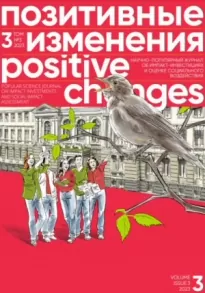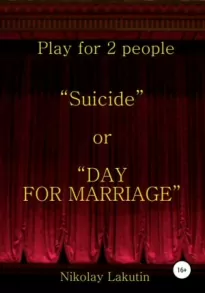Позитивные изменения. Том 3, № 3 (2023). Positive changes. Volume 3, Issue 3 (2023)

- Автор: Редакция журнала «Позитивные изменения»
- Жанр: Научная литература / Газеты и журналы
- Дата выхода: 2023
Читать книгу "Позитивные изменения. Том 3, № 3 (2023). Positive changes. Volume 3, Issue 3 (2023)"
Center for Neuropsychological Correction of Children and Adolescents
Improving the Quality of Life and Social Adaptation of Children with Developmental Disorders.
www.cndip.ru
The Center provides remedial classes (neuropsychological correction, speech therapy, ABA therapy) for children and adolescents with developmental disorders, including autism spectrum disorders (ASD) and learning difficulties. The purpose of the classes is to help the students acquire vital life skills, adapt to society, and overcome learning difficulties.
PROBLEM ADDRESSED
About one in 44 children at the age of eight are diagnosed with autism spectrum disorders, boys being affected on average 4 times more frequently than girls. These statistics are supported by data from the U. S. Centers for Disease Control and Prevention.
According to the Russian Ministry of Health, the occurrence of autism spectrum disorders (ASD) in Russia mirrors global rates, affecting roughly 1 % of the child population. This translates to an estimated 300,000 or more ASD cases diagnosed in Russia, based on the country’s 30 million children.
Applied Behavior Analysis (ABA) therapy is the only scientifically proven method for working with children diagnosed with ASD. Unfortunately, less than 5 % of children with ASD have access to this treatment. Several factors contribute to this situation, including the high cost of the therapy, which typically requires 2 to 5 years of regular sessions. Additionally, there is a lack of awareness among both parents and professionals, as well as a noticeable absence of government involvement in supporting families with children on the spectrum.
The Center for Neuropsychological Correction of Children and Adolescents is a pioneering institution located in Podolsk, and it stands as the largest of its kind in the city. The Center is dedicated to providing support and interventions for children with developmental disorders and unique developmental needs. Their services extend to a diverse range of children, from neurotypical students experiencing academic difficulties to those with speech and psychological developmental delays, as well as those affected by ADHD. Notably, the majority of the Center’s customers are children with ASD.
The Center’s goal is not just to help children with developmental disabilities to adapt to living in the society; it also strives to foster inclusivity and understanding, changing the attitude of the professional community to these children and their abilities.
METHODS USED TO ADDRESS THE PROBLEM
The Center operates in three key directions: ABA therapy, neuropsychological correction and speech therapy. During the initial diagnostic phase, specialists assess the child’s developmental level, strengths and weaknesses, and subsequently determine the specific types of sessions required for the child’s benefit.
ABA therapy encompasses various aspects, including:
• communication enhancement (focusing on eye contact, pointing gestures, name responsiveness, requests, and dialogic speech);
• teaching socially acceptable behaviors in the public setting;
• addressing and correcting all manifestations of unwanted behaviors, such as aggression, screaming, headbanging, biting, and more;
• fostering an understanding of other people’s intentions, sarcasm, and humor;
• facilitating potty training and the acquisition of other domestic skills and self-care routines;
• addressing disobedience and resistance to learning;
• broadening the child’s dietary preferences;
• cultivating effective peer communication and interaction, encouraging socialization and collaborative play.
“Our sessions are primarily one-on-one, following custom programs crafted for each child based on their unique challenges. Most commonly, we address cooperation and behavioral issues. Children with autism tend to resist specialist sessions, often resorting to screaming outbursts, pinching themselves and the others, and, at times, even banging their heads against the walls. Our approach focuses on motivating them to cooperate through their intrinsic interests, teaching them to complete assigned tasks, and, of course, correcting undesirable behaviors,” says Anna Nikitina, Head of the Center for Neuropsychological Correction of Children and Adolescents.
Nikitina also notes that speech-related challenges are frequent. “Many children are non-verbal, and our focus is to help them start speaking. Even if a child cannot speak, they can effectively convey their needs through gestures and facial expressions, which is entirely normal. Children with autism, however, often grapple with communication difficulties, so we work on fostering eye contact as a means of communication, employing pointing gestures to express requests, and encouraging head nodding, among other techniques,” she adds.
The Center welcomes children with high-functioning autism as well — those who can thrive in conventional schools, boasting high intelligence and well-developed speech abilities. Nevertheless, these children may face challenges in interpersonal interactions, such as difficulties understanding humor, sarcasm, instead interpreting statements literally.
Sessions at the Center for Neuropsychological Correction of Children and Adolescents are typically conducted from 3 to 6 days a week, with an average duration of 1.5 hours per session. Additionally, mentors provide guidance to parents on working with their children at home. While the structure of each session is meticulously tailored to suit the unique needs of every child, there are two universal principles that apply to every single case:
1) In every session, specialists follow personalized protocols meticulously crafted by supervisors, rooted in the goals of the ABA program. Each protocol provides a comprehensive roadmap for teaching a specific skill, encompassing the objective of the lesson, criteria for success, and step-by-step instructions.
2) Sessions are designed to captivate the child’s interest, often adopting a playful format. For younger children, these sessions typically feature a multitude of motivational tasks and games to engage and motivate the child effectively.
During each session, our specialist meticulously keeps records against a checklist. Each child has a dedicated curator, who monitors the records regularly and uses them as the foundation for adjusting and enhancing the personalized ABA program. Every three months, the curator compiles a comprehensive written report for the parents, detailing the milestones achieved during the period and formulating new goals for the next three months.
Our sessions also encompass active parental involvement. Every two weeks, the curator provides parents with a detailed work plan for the next 7–10 days via email or in-person consultations. In response, parents are expected to submit video recordings and notes documenting their at-home efforts and describing the quantity and quality of the child’s reactions. The curator reviews the submissions and returns with constructive feedback within 3–5 days. Additionally, parents are encouraged to attend their child’s sessions, which grant them invaluable insight into the specialist’s interactions and methods.
ACCOMPLISHMENTS AND AWARDS
Victory in the Social Entrepreneur-2019 competition of social projects run by the Our Future Foundation.
Participant and award winner of the “Start Differently” inclusivity-related social projects program operated by Rosbank and Impact Hub Moscow in 2022.
FUNDS RAISED IN 2022
Profit from services provided (approximately RUB 33 million).
WHAT WAS DONE LAST YEAR
• Completed digitization of administrative processes, identifying key performance indicators to assess the performance;
• Established financial accounting procedures (separate financial statements for the two branches; started income and expense tracking, etc.);
• Successfully implemented a CRM system covering all critical processes (project initiated in 2022 and completed in 2023);
• Established a strategic partnership with a university, with an online department opened at the Institute of Organizational and Clinical Psychology in Moscow;
• Started development of a customer service framework. As part of this process, introduced regular surveys and interviews with parents and professionals at all levels of service delivery. Appointed a dedicated specialist to process data and offer solutions to emerging challenges. Monthly parental surveys are now facilitated by our “Caring Bot” on the Telegram messaging platform.
DIRECT RESULTS FOR 2022
Corrective sessions held for 615 children, including those with ASD.
329 one-off services provided (consultations and diagnostic sessions).
20+ educational lectures organized for parents, educators, and other professionals.
A dedicated team of more than 30 specialists working with children at the Center.
SOCIAL EFFECTS ACHIEVED IN 2022
The Center collects comprehensive performance records for each child. These showcase some remarkable outcomes, including enabling speech development in non-verbal boys and girls, behavior correction in many children, diversifying their dietary preferences, and facilitating potty training. Some children have successfully transitioned to kindergarten and regular schools.
“I remember the case from my practice, where a boy could only request three items. After just two months of sessions, his request count had surpassed 300. It is an exceptional outcome, but this child had a reasonably solid baseline understanding of speech, and he exhibited no undesirable behaviors. Another boy arrived at our Center at the age of three. He kept banging his head against the wall, avoided eye contact, disregarded people, kept darting around the room, and exhibited stimming behaviors (repetitive movements, sounds, actions — ed. note). Today, this boy goes to a public school, studying with regular children in a regular class. While he still retains some behavioral idiosyncrasies, he actively engages with other kids and keeps up with the school curriculum. Keep in mind, though, that not all children with autism achieve such remarkable results. In this particular boy’s case, it took several years of hard work. He spent four years at our Center, attending all kinds of sessions, including ABA therapy, neuropsychological correction, and speech therapy. Ultimately, it was the tremendous commitment and effort invested by the boy’s parents and his grandmother that played pivotal role in his progress,” Anna Nikitina recounts.
FINANCIAL SUSTAINABILITY MODEL
Profit from services provided to individuals (sales of subscriptions and one-off consultations) and legal entities (lectures and workshops for the university).
IMPACT ASSESSMENT METHODS
The Center systematically tracks key performance indicators, including the number of subscriptions sold, additional sessions and consultations provided, lectures and seminars held, and participation in outreach events.
Keeping records, charts, precisely recording goals and outcomes is a crucial aspect of ABA therapy. This is why the Center generates monthly and quarterly reports to monitor progress. “Let’s say a child comes to us for the first time. The first thing we do is we conduct the testing. We talk to the parents, to discover which skills the child has and which ones are missing, what we should be working on. Sometimes the testing process takes three sessions, and in some cases it may span an entire month. During this time, we run tests and we work with the child. We create an individualized program, establish goals, and set the timeline for achieving these goals. The parents review the progress report with a specialist every three months, and together they make informed decisions about the way forward based on the progress achieved so far,” Anna Nikitina explains.
For children with autism, making requests can be a challenging skill. The Center’s specialists make sure they measure the number of requests made before therapy and compare it to the number after three months of intervention. Then they set new goals based on the progress. If the child lacks the ability to make pointing gestures, one of the objectives could be for the child to use pointing gestures (pointing with a finger) to make requests at least 20 times a day after one month.
The organization has devised a Theory of Change. The Center’s overarching goal is to transform the lives of over 5,000 individuals within a 5-year timeframe by enhancing the accessibility of rehabilitation services for children with ASD. This strategic goal requires establishing three additional centers over the next five years. The expansion is expected to yield several significant outcomes:
• a 30 % reduction in the cost of sessions, making them more affordable
• the ability to provide assistance to over 500 children concurrently
• more free lectures and workshops for parents, educators, and healthcare professionals.
Ultimately, these initiatives are projected to bring forth a qualitative improvement in the lives of more than 5,000 people, including children with ASD and their families. More than 2,000 children are expected to continue their education in kindergartens and schools as a result of successful therapy and increased overall awareness. Consequently, there should be a reduction in the number of children who require invasive interventions due to the limited knowledge of specialists in related fields.





